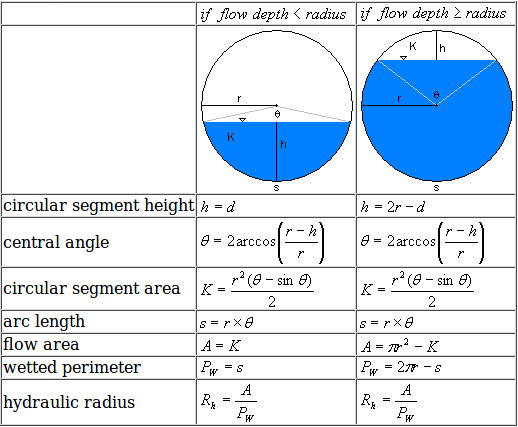Culvert formula (Water Overlay): Difference between revisions
Jump to navigation
Jump to search
No edit summary |
No edit summary |
||
| Line 17: | Line 17: | ||
: <math>U = \sqrt{ \frac{1}{ 1 + \frac{2g \cdot n^2 \cdot length }{ R_{h}^{\frac{4}{3}}} }}</math> | : <math>U = \sqrt{ \frac{1}{ 1 + \frac{2g \cdot n^2 \cdot length }{ R_{h}^{\frac{4}{3}}} }}</math> | ||
The hydraulic radius <math>R_h</math> is calculated using the formula's in the image on the right. | The hydraulic radius <math>R_h</math> is calculated as: | ||
: <math>R_h = \frac{A}{P_w} | |||
For circular culverts, the flow area <math>A</math> and the wetted perimeter <math>P_w</math> is calculated using the formula's in the image on the right. | |||
For square culverts, the flow area and wetted perimeter is calculated as followed: | |||
The potential flow through the culvert is then calculated: | The potential flow through the culvert is then calculated: | ||
| Line 31: | Line 37: | ||
* <math>w_{l}</math> = The [[Surface water level formula (Water Overlay)|water level]] on the left end of the culvert, relative to {{datum}}. | * <math>w_{l}</math> = The [[Surface water level formula (Water Overlay)|water level]] on the left end of the culvert, relative to {{datum}}. | ||
* <math>w_{r}</math> = The [[Surface water level formula (Water Overlay)|water level]] on the right end of the culvert, relative to {{datum}}. | * <math>w_{r}</math> = The [[Surface water level formula (Water Overlay)|water level]] on the right end of the culvert, relative to {{datum}}. | ||
* <math>h_{l}</math> = The relative water height on the left end of the culvert. | |||
* <math>h_{r}</math> = The relative water height on the right end of the culvert. | |||
* <math>R_h</math> = The hydraulic radius in the culvert<ref name="hydradius"/>. | * <math>R_h</math> = The hydraulic radius in the culvert<ref name="hydradius"/>. | ||
* <math>K</math> = | * <math>R_w</math> = The wetted perimeter. | ||
* <math>A</math> = The flow area. | |||
* <math>K</math> = Circular flow area, based on the height of the water in the (circular) culvert. | |||
* <math>g</math> = Acceleration factor of [[Gravity (Water Overlay)|GRAVITY]], defined for the Water Overlay. | * <math>g</math> = Acceleration factor of [[Gravity (Water Overlay)|GRAVITY]], defined for the Water Overlay. | ||
* <math>L</math> = The length of the culvert, calculated as the distance between the culvert's endpoints. | * <math>L</math> = The length of the culvert, calculated as the distance between the culvert's endpoints. | ||
Revision as of 15:22, 8 October 2020
Flow through culverts is based on an open channel flow calculation.
The actual height of the culvert is at least the height of the terrain on either end of the culvert and the provided threshold height:
The radius of the culvert:
The height of the water column at either end of the culvert, relative to the culvert, is calculated:
Flow depth d is:
The loss coefficient for the culvert is calculated:
The hydraulic radius is calculated as:
- and the wetted perimeter is calculated using the formula's in the image on the right.
For square culverts, the flow area and wetted perimeter is calculated as followed:
The potential flow through the culvert is then calculated:
Finally the actual amount of water flow is calculated:
Where:
- = The CULVERT_DIAMETER attribute of the culvert.
- = The CULVERT_THRESHOLD attribute of the culvert.
- = The surface height of the base of the culvert.
- = The water level on the left end of the culvert, relative to datum.
- = The water level on the right end of the culvert, relative to datum.
- = The relative water height on the left end of the culvert.
- = The relative water height on the right end of the culvert.
- = The hydraulic radius in the culvert[1].
- = The wetted perimeter.
- = The flow area.
- = Circular flow area, based on the height of the water in the (circular) culvert.
- = Acceleration factor of GRAVITY, defined for the Water Overlay.
- = The length of the culvert, calculated as the distance between the culvert's endpoints.
- = Loss coefficient for culverts.
- = The CULVERT_N attribute of the culvert.
- = The potential rate of water flow through the culvert.
- = The water flow which takes place.
- = Computational timestep.
- = Cell size.
Related
The following topics are related to this formula.
- Structures
- Culvert
- Models
- Surface model
References
- ↑ Hydraulic Radius Equations Formulas Calculator ∙ found at: https://www.ajdesigner.com/phphydraulicradius/hydraulic_radius_equation_pipe.php ∙ (last visited 2019-02-11)


































